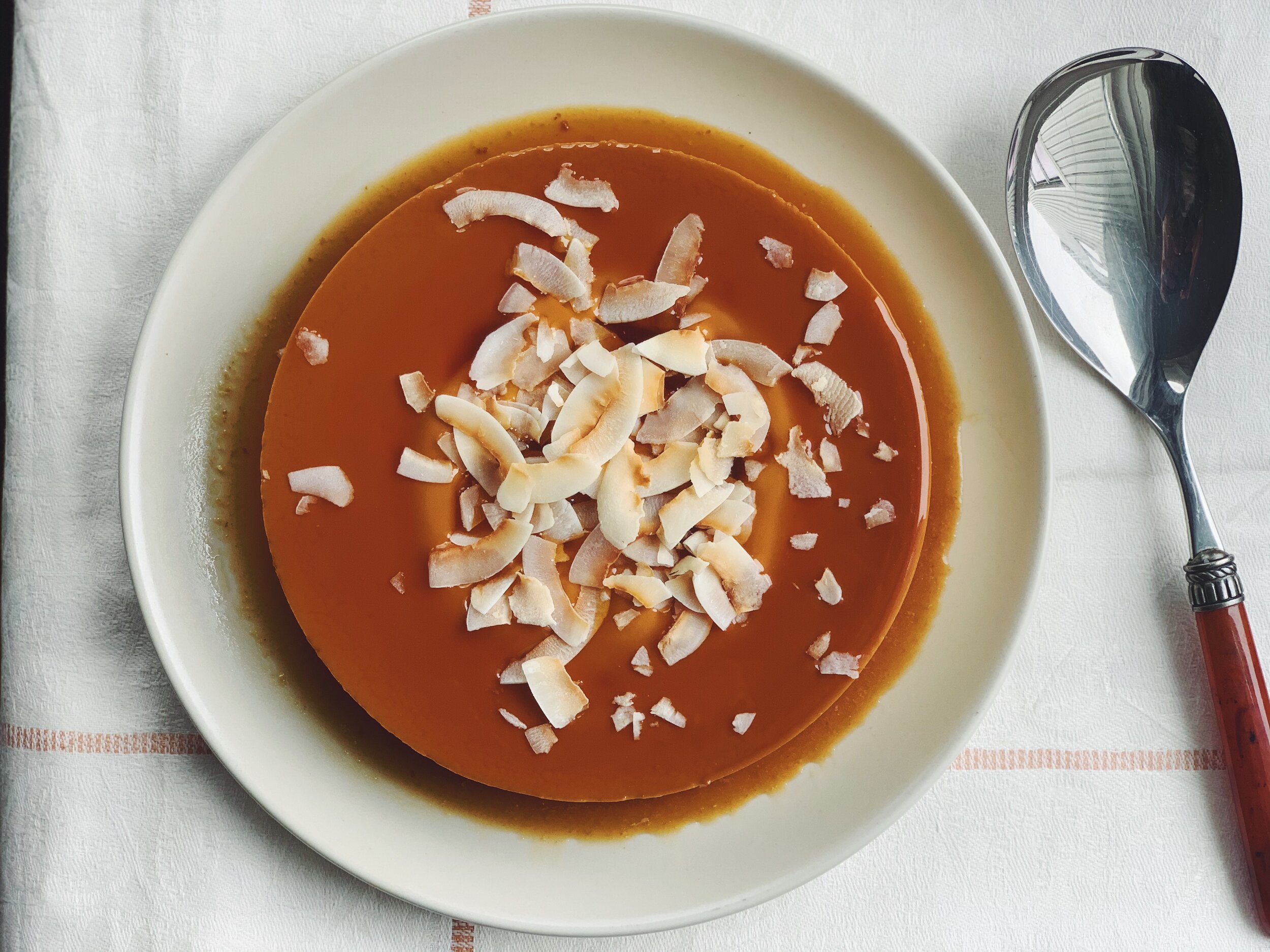Creme Caramel al Cocco
I’ve loved this indulgent spoon dessert since I was a child. But the thought of making it struck fear in my heart. First, there’s the making of the caramel itself, which is used to coat the inside of the baking dish or mold. How in the world to manage this without the caramel seizing up into a crystallized mess, which is what always seemed to happen to mine? Then there’s the baking of the custard in a water bath that must be very hot but not boiling hot. Bake it at too low a temperature and the custard won’t set properly; too hot and you end up with rubbery pudding pocked with those dreaded little bubbles that mar what should be a perfectly dense, smooth crème.
I’m happy to say that I’ve mastered this longtime favorite, and you can, too. Read the recipe closely and follow the instructions. Use the proper equipment—a heavy-bottomed saucepan for the caramel is crucial—and pay attention to visual cues. And remember, even if you have some hiccups the first time around, the process will become easier each time you do it.
I’ve chosen coconut because it’s just a little more special than classic crème caramel and it also happens to be just right for the in-between season; that is, early spring, when citrus season is on the wane and the only apples left are the mealy cold storage ones, but it’s still too early for strawberries.
CRÈME CARAMEL AL COCCO | COCONUT CRÈME CARAMEL
Makes 6 servings
INGREDIENTS
1 cup (200 g) sugar
1/4 cup (60 ml) water
1 (13.5-oz; 400 ml) can coconut cream
1 (14-oz; 400 ml) can sweetened condensed milk or sweetened condensed coconut milk
1 cup (231 g) heavy whipping cream
4 whole large eggs plus 2 yolks
1 cup unsweetened coconut chips, toasted (see NOTE)
INSTRUCTIONS
1. Position a rack in the center of the oven and preheat to 325° F (160° C).
2. Make the caramel. Have your baking dish nearby. I use a 2-quart ceramic soufflé dish. Start with a heavy-bottomed saucepan, which makes all the difference. I use a stainless-steel saucepan with a copper core, which conducts heat well. Pour the sugar into the middle of the saucepan and pour the water around it in a moat. Turn the heat on medium-low and stir to dissolve the sugar. When the sugar is mostly dissolved, turn the heat up to medium to medium-high and let the mixture come to a simmer. It will start to boil; this is what you want. Swirl it around a bit using the handle of the saucepan, but don’t stir it with a spatula. Continue to cook, with the occasional swirl, until the mixture starts to change color. It will go from clear to opaque and eventually take on a golden tinge. Once that happens, your caramel will form quickly, so watch closely, swirling gently to distribute the heat. When the caramel has turned a deep gold and has a rich caramel aroma, remove it from the heat and immediately pour it into the soufflé dish. Rotate the dish to completely coat the bottom and a little up the sides. Set aside to cool (it will harden quickly).
3. Fill a teapot with water and bring it to a simmer—just under a boil. If the water boils, take it off the heat and let it cool down a bit.
4. While the water is heating, make the crème. In a large bowl, whisk together the coconut cream, condensed milk, and heavy cream. Whisk in the whole eggs and yolks. Pour the mixture through a fine-mesh sieve into the prepared soufflé dish. Set the dish into a large oven-proof pan; I use a 12-inch by 2-inch (30 cm-by 5 cm) aluminum baking pan. Carefully pour the hot water into the pan, enough to reach about halfway up the outside of the soufflé dish.
5. Carefully set the pan—use oven mitts, as the pan will be hot from the hot water—into the oven. Bake for 60 to 70 minutes, or until the custard is nearly set; it should still be jiggly in the center. Check the custard as cooking nears the 60-minute mark; if you see that the water in the pan is beginning to boil, or that bubbles are forming around the edges of the custard, turn the heat down to 300° F (150° C ).
6. When the custard is mostly set, with a still-jiggly center, remove it from the oven. Remove the soufflé dish or baking dish from the water bath and set it on a rack to cool to room temperature. Once cooled, cover the dish with reusable wrap, foil, or plastic wrap, and chill overnight in the refrigerator. To serve, slide a thin paring knife around the periphery of the baking dish and invert the crème caramel onto a serving plate, allowing the caramel to drip over the top. Garnish with toasted coconut chips right before serving.
NOTE: Coconut chips are the large, flat shavings of desiccated coconut; not the sweetened shredded coconut flakes such as Baker’s. To toast them, spread the shavings out on a baking sheet and bake at 325° F (160° C) for 3 to 5 minutes, or until lightly browned. Keep a close watch, as coconut can quickly go from pale gold to burnt. Let cool before garnishing the crème caramel.

